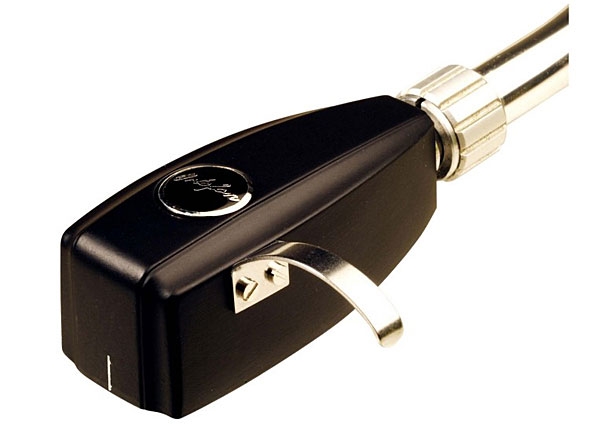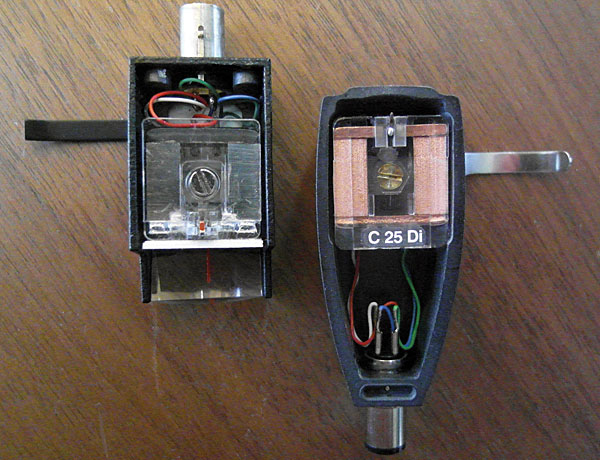| Columns Retired Columns & Blogs |
Listening #148

"Too much Stokowski."—Sergei Rachmaninoff in 1940, reacting to a demonstration of a stereo recording of Leopold Stokowski conducting the Philadelphia Orchestra
Footnote 1: Ortofon A/S, Stavangervej 9, DK-4900 Nakskov, Denmark. Web: www.ortofon.com. US: Ortofon Inc., 500 Executive Blvd., Suite 102, Ossining, NY 10562. Tel: (914) 762-8646. Fax: (914) 762-8649. Web: www.ortofon.us.
I don't remember when, but at some point during the past few years I realized that, in my home, mono cartridges outnumber their stereo counterparts. A few weeks ago, my collection of phono equipment took another step in the same strange direction: After receiving from Ortofon a sample of their CG 25 DI Mk.II mono pickup head ($902) for review, I was so impressed with its sound that I asked if I could buy the review sample. Now, having put check in mail, I own twice as many mono cartridges as stereo ones. Take that, multichannelism.
The strangeness is heightened by the fact that the CG 25 is, apparently, the oldest product presently made by the world's oldest audio manufacturer. Regarded by Ortofon as a member of their historic SPU line—this despite the fact that the S in SPU stands for stereo—the design of the CG 25 harks back to an era when all pickups were bulky, low-compliance, resolutely monophonic things. Indeed, the CG 25 reminds us that it was Ortofon from whom the German turntable manufacturer Elektro-Mess-Technik purchased their first tonearms and pickups: The pickups that EMT later designed and made for themselves were clearly influenced by the products of their Danish colleagues, no surer signs of which are the striking physical similarities between the Ortofon CG 25 DI Mk.II and EMT's recently discontinued OFD 25.

A ca-2008 sample of the EMT OFD 25 (left), next to the Ortofon CG 25 DI MKII, each minus its removable belly pan. Note that the Ortofon's cantilever is fastened to the motor armature with a minute dab of solder, as in olden days. (Photo: Art Dudley)
Like that EMT OFD 25, whose praises I've sung in this space, the Ortofon CG 25 DI Mk.II is a moving-coil cartridge with a single coil, the ends of which are paralleled to both pairs of output contacts on its stereo-compatible headshell. Also like the EMT, the Ortofon has a hefty, stiffly suspended, flat-metal cantilever, and a spherical stylus tip with a radius of 25µm (from which the model designations of both products derive). That size and shape of stylus is ideal for playing monophonic vinyl ranging from the very first LPs of 1948 through the mono records of the early 1960s, plus select mono records made in later years—a topic to which I'll return in a moment.
But there are differences between these two pickups, the most significant of which point to the CG 25's use of fewer turns of coil wire: The Ortofon has a lower internal impedance (6 ohms vs the OFD 25's 37 ohms) and, of perhaps greater consequence, a much lower output (1.5 vs 5.75mV). The CG 25 DI Mk.II also has a stylus with a shank of titanium—a metal that tends to make even the diamond tip appear darker than usual, especially to the naked eye—and a headshell of wood composite press-molded into shape, then machined for a precise fit and a fetching finish.
Even before my first spin with this new-old pickup, the CG 25 gave me cause to smile: Its 1.5mV output is more in line with the 1.05mV output of my reference stereo cartridge, the EMT TSD 15. By contrast, when I use my EMT OFD 25 and OFD 15 pickup heads, I'm forced to adjust not only the playback volume of my Shindo preamp but also to change the input gain on my Shindo power amps. (My preamp and amps alike provide greater-than-average gain, a situation complicated by my use of the Hommage T2 step-up transformer, itself a source of much higher gain than other transformers to which the EMT cartridges are suited.) Without such compensation, the OFD pickup heads force me to keep the preamp's volume control scarcely above zero—a range in which stereo potentiometers perform notoriously poorly.
Used in my Thomas Schick tonearm—for which I recently made a mounting pod of its own, mounted to the plinth of my Garrard 301 turntable alongside the similarly articulated EMT 997 tonearm—the Ortofon CG 25DI Mk.II now drives my preamp's built-in, Ortofon-friendly, Lundahl phono transformers, while the stereo EMT TSD 15 pickup continues to drive the outboard Hommage T2 transformer, itself connected to the preamplifier's moving-magnet inputs. This arrangement offers surprisingly good volume-level parity between stereo and mono.
Even more important, the sonic performance of the Ortofon CG 25/Lundahl combination is exceptional: This is among the hallowed few cartridges that really communicate everything that's special about 1950s and '60s mono LPs from the likes of Verve, Prestige, Clef, Columbia, and other labels, not to mention the best contemporary mono records. For example, when playing the Electric Recording Company's mono reissue of Mozart à Paris (7 LPs, Pathé DTX 191–197), the CG 25 uncovered as much presence and force as I've heard from those strangely dry recordings. And while it didn't shy from putting across the overly piquant tone that affects some of the original recordings in that set, neither did the Ortofon render those selections harsh or strident. Similarly, the CG 25 pulled huge amounts of color and texture from my favorite Verve jazz LPs, including The Jazz Soul of Oscar Peterson (Verve MG V-8351)—with which the Ortofon also showed off its ability to all but ignore even the most severe surface noise.
The EMT OFD-series pickups, when used with the Hommage transformer,1 remain the most vivid and tactile mono pickups I've heard, but the CG 25 DI Mk.II delivers nearly the same level of performance for a much lower price. Now I save my own OFDs for those special Mono Weekends when I change my system settings to accommodate them, and for everyday listening I use the new Ortofon—which is anything but commonplace.
Music of the sphericals
"Mono is literally half the information in a mix."
The source of that wisdom, which I recently read on Facebook, was a man who identified himself as a "sound engineer," and who wondered why anyone would want to "force" a high-end music system to play mono. I didn't join the conversation, partly because I'm not very good at hiding my contempt for ill-informed people who pass themselves off as experts—of which the online world has no shortage—and partly because, by saving my opinions for this space, I can be paid for expressing them. Ka-ching is the rare noise that sounds equally good from one loudspeaker or many.
As recently as a year ago, I could have forgiven even the most ignorant experts for misunderstanding monophonic sound—which is, of course, the technological basis of all commercial music recordings made before 1954, and of a great many others made between then and the late 1960s. But forbearance has its limits. Not only did the LP record emerge as the music industry's surprise hit of 2014—according to Nielsen SoundScan, between January and June of last year, vinyl sales showed a 40% increase over the same period in 2013—but brand-new reissues of historic mono recordings accounted for a notable share of that success.
Late last year, the holiday-season catalogs and promotional e-mails I received from my favorite vinyl pushers included dozens of new mono reissues, from such artists as Bob Dylan, Sonny Rollins, Wilhelm Furtwängler, J†nos Starker, Duke Ellington, Lester Young, Django Reinhardt, Jascha Heifetz, John Coltrane, Coleman Hawkins, Miles Davis, Otis Redding, the Beach Boys, and, of course, the Beatles. Some are records that were never released in anything but mono—Furtwängler and Reinhardt, for example, died before stereo LPs became a commercial reality—while others, such as the latest waves of Beach Boys and Beatles reissues, are the mono versions of records that many of us have long enjoyed in stereo.
In fact, following the publication of my column on those Beatles reissues ("Listening," December 2014), I heard from a number of readers, virtually all of whom wanted to know the same thing: Do I have to buy a mono cartridge to get the most out of these new mono LPs? The answer depends in part on the phono gear one already owns, and in part on one's taste in sound—and, to put it bluntly, on what it is one hopes to get from those records.
The last of those things is the easiest to address: In creating the mixes from which their mono records were mastered, the Beatles and their engineers—and other artists and engineers with multitrack facilities at their disposal—often chose different single-track playback levels, applied different effects, and selected different performance takes from the ones used to make their stereo mixes. For the enthusiast who wishes, above all else, to hear and enjoy those distinctions, a dedicated mono phono cartridge is not a necessity.
Footnote 1: Ortofon A/S, Stavangervej 9, DK-4900 Nakskov, Denmark. Web: www.ortofon.com. US: Ortofon Inc., 500 Executive Blvd., Suite 102, Ossining, NY 10562. Tel: (914) 762-8646. Fax: (914) 762-8649. Web: www.ortofon.us.
Footnote 2: Interestingly, the combination of CG 25DI Mk.II and Hommage T2 transformer was nothing special: good but not great. Ortofon's own mono-specific ST-M25 step-up transformer ($600) sounded quite good with the CG 25, but didn't have quite the bass weight as when I used the Ortofon pickup through the stock Lundahls.
- Log in or register to post comments




































